
Tr189 on shed at Maymorn, during commissioning tests on 9 March 2013. Photo: Ben Calcott.
Adopted: 6 November 2013
The predominant physical project work for the Trust during 2012-2013 was focused on developing railway facilities at Maymorn, 6km northeast of Upper Hutt. In the future this will be the departure point for heritage train services that the Trust proposes to operate over the former railway route between Upper Hutt and Featherston. Maymorn station is ideally situated, connected to Upper Hutt, Wellington and the Wairarapa via current Tranz Metro passenger services, and only a short distance from the heritage railway route proper.
Facilities at Maymorn currently under development, whilst currently required for the construction phase, will be used without modification for the future railway operation. For example, the rail vehicle shed will eventually be used to store operational locomotives and carriages, and initial railway track being built will become our future mainline at the station building. Significant milestones were achieved for the rail vehicle shed during the year: completion of the main roof structure, installation of train doors and pedestrian doors — which means that we now have a secure facility. Once the rail vehicle shed and initial track developments are further advanced attention will increasingly turn to presenting local railway heritage to the public at the Maymorn site.
Some of the key achievements during the year included the commissioning of our shunt locomotive Tr189, transporting the 'Cyclops' English Electric multiple unit from Hutt Workshops to Maymorn for the multiple unit group and connecting our mainline to shed track, including the double slip and a new turnout.

The Maymorn operational base is important in a number of ways. It is the current focus of volunteer activity, which the Trust is entirely reliant upon for its future. Tranz Metro Wairarapa Line passenger services service Maymorn, which provides connection to and from Wellington, the Hutt Valley and the Wairarapa — and strategically, a future life-line for tourist visitation to the railway. The facilities under construction at Maymorn will protect the Trust’s current rail vehicle fleet, and facilitate their future restoration, operation and maintenance. Plans have also been prepared and resource consent approved for a large station building incorporating a visitor centre, historic and interpretative displays, and a cafe. These facilities will play a central role in the Trust’s future operations, being the departure point for a journey back in time over the historic Rimutaka Incline.

On 15 August 2012 a major concrete pour was made, with several pit floor slabs completed and an extension of walls. By the end of the year both inspection pit tracks were largely complete.

The rail vehicle shed at Maymorn has been the primary project for the Trust over the last five years. A huge amount of design work, engineering consultation, planning and project management has gone into the structure. The vast majority of the foundation work, component fabrication and final construction have been undertaken by volunteers working in their spare time. The decision to replicate an original 1911 New Zealand Railways 2-road engine shed design has paid dividends in that the Maymorn station has a real railway depot “feel” about it. The building will also complement future heritage railway operations.
We are indebted to Rimutaka Charitable Trust, Hutt Mana Charitable Trust, Pelorus Trust and Lion Foundation for their continued support for the project, with considerable funding put into the rail vehicle shed in particular.
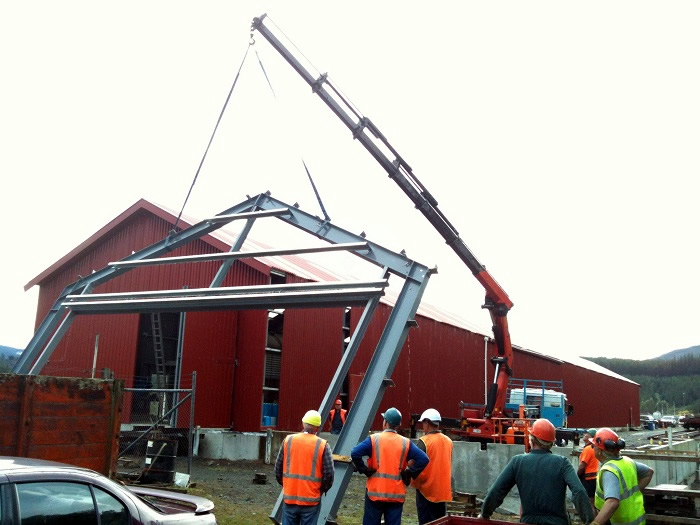
A long-awaited milestone - the first workshop portal frames lifted into position on Saturday 13 April 2013. A huge amount of planning, fundraising and preparation has gone into this part of the shed build, with most work done by Trust members.
Construction of workshop and servicing facilities are being built as an extension to the south of the main shed. The 15-metre long workshop structure is of similar design to the rail vehicle shed and gives the appearance of a 4-road engine shed when viewed end-on. The rationale for the workshop is to provide space for a machine shop for future restoration and maintenance of locomotives, carriages and wagons.
There is a window of opportunity to efficiently construct the workshop, dovetailing onto structural work associated with the rail vehicle shed. Engineering approval and building consent have been relatively easy to obtain, in contrast to revisiting this work at a later date. Volunteers are also experienced with the required building work — but within two years this building work will be regulated and require licensed builders on the job. The workshop is also a condition of the Trust’s Resource Consent for rail activities at Maymorn.
Building our mainline track through the Maymorn yard towards Kaitoke is a tangible step we can make at this early stage in the railway’s development. The extent of the work achieved has been possible due to a great deal of support from the rail civil engineering industry. We are also fortunate to have Trust members skilled in both project management and track construction to plan and carry out this work. The extension of our future mainline track through the Maymorn station is helping to transform the current construction site into an operational base for our railway.
Major donations of track materials received from KiwiRail and Holcim (New Zealand) Limited have been used to extend the mainline at Maymorn station.
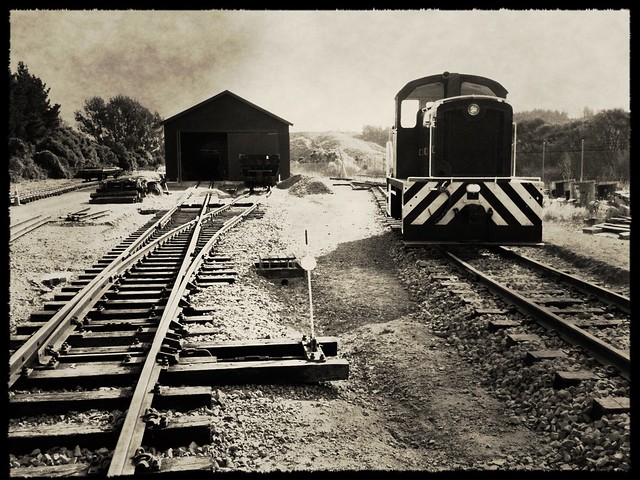
By 16 March 2013 we had laid, ballasted and tamped the first portion of the future turntable road, work brought forward to permit a temporary connection to the Wairarapa Line in order to bring the 'Cyclops' English Electric unit onto site on 21 April.

The Trust assisted the Wellington Multiple Unit Preservation Heritage Trust with their goal of saving at least one English Electric set for future operation on the Wellington urban network. We signed an agreement with the trust for storage and maintenance of the Cyclops set at Maymorn. It was a pleasing outcome the be able to assist the Wellington Heritage Multiple Unit Trust and Greater Wellington Regional Council in providing a space to preserve one of these trains in the Wellington region and look forward to future operation of the unit on the Wellington urban network.
Key track and infrastructure work at Maymorn was brought forward so that the unit can arrive by rail. This included work on the double slip, building a new road two turnout, the turntable road, and the road four siding alongside the rail vehicle shed.
The Trust project-managed the hook and tow of the units from Hutt Workshops to Maymorn under our rail licence, working closely with KiwiRail and the New Zealand Transport Agency.
The English Electric units had their final run on the Johnsonville line on 19 March 2012, which was the last run for the Dm556 set, commonly referred to as 'Cyclops'. Three remaining blue liveried ex-Johnsonville sets were used on the Hutt Valley line for a few more months through to June 2012, with a last run on 25 June 2012.
Much work has also been put into the connection route between Maymorn and the heritage formation leading towards Tunnel Gully. The connection route is an essential component of the Rimutaka Incline Railway.
A preferred route has been identified and has been incorporated into the Upper Hutt City Council's Maymorn Structure Plan.
The structure plan proposes a multi-stage urban development for the Maymorn area, with a railway corridor for the Rimutaka Incline Railway climbing out of Maymorn station. We recommended that additional integration and connections be put in place so that the railway passes through a "railway reserve", highlighted and made prominent in the urban landscape — and so that visitors might be able to view the heritage railway operations first-hand from adjacent cycleways, paths and carriageways.
The railway reserve and associated walk and cycleway will enable additional connecting routes to be formed between the hub of the community — the railway station — the Greater Wellington Regional Council park land leading into Tunnel Gully, and the walkway proposed to be located along the historic railway route leading towards Mangaroa. This will reinforce and promote use of the existing Tranz Metro service for cycle and walking recreational activities to and from Maymorn station. Additionally, the Trust has incorporated a cycleway / walkway into its wider proposal for a heritage railway along the historic railway route to Kaitoke and Summit. Providing an adjacent cycle / path in the railway reserve will maintain the nature of the route as it passes through the Maymorn urban area. There will also be a significant public good in having the heritage railway operations viewable from the adjacent cycle / path.

Heritage railway formation looking north from Maymorn on the climb to Tunnel Gully. Photo: Hugh McCracken.

An impression of how the railway reserve could look in elevation — with reserve, cycle / path, berm and carriageway elements. Drawing: Ben Calcott.
The Trust has been a licenced rail operator and rail network provider since 26 June 2009. Operations have continued through the 2012-2013 year, which saw the Trust complete its second external annual safety assessment carried out by the New Zealand Transport Agency, with a good report. The Trust's shunting locomotive, Tr 189, was commissioned in March 2013, marking the start of train operations on our railway.
I would like to acknowledge and thank the Trustees for their substantial commitment to Rimutaka Incline Railway vision, and Trust members and friends who continue to support the railway both through donations and thousands of hours of voluntary effort per year. The Trust’s achievements to date have only been possible through their dedication and support.
Hugh McCracken
Chairperson

Within a few years we hope to be crossing this historic culvert on heritage formation between Maymorn and Tunnel Gully.
The Trust’s activities and railway operation is managed through four committees:
The Land, Site, Fundraising and Rail Management committees rotate through a fortnightly meeting appointment, so that each committee meets every 10 weeks.
The Trust continues to develop its operational base at Maymorn. We have a long-term lease of much of the former Maymorn railway yard from New Zealand Railway Corporation (trading as KiwiRail). It is an ideal location from which to commence the railway, having potential to connect with the Wairarapa railway line, and being in close proximity to the former heritage railway route.
The connection route between Maymorn and the heritage formation leading towards Tunnel Gully has seen further work this year. Exploratory survey work was undertaken by Trust members, to a level sufficient to prove the feasibility of the alignment incorporated into the Maymorn Structure Plan (as discussed earlier in this report). Data obtained from the survey was used to model the landforms and property boundaries, and a route designed to make best use of the available landforms, conform to minimum curvature (100m radius) and maximum gradient (1 in 35) restrictions, and connect in with the KiwiRail corridor and the heritage railway formation respectively. Between all these design restrictions sufficient route length has been obtained to regain the heritage railway formation as it climbs towards Tunnel Gully. The route is at the limits of conventional railway design standards, consistent with the remainder of the heritage route to Kaitoke and Summit.

Proposed alignment of connection route climbing out of Maymorn, showing possible integration into a network of cycle / pathways, connecting into a walkway along the heritage railway formation that heads to the south up the Mangaroa Valley, and both railway and walkway connecting into Tunnel Gully. Drawing: Ben Calcott.
As mentioned in the Chairperson’s report, the railway has been operating under a full rail licence since 26 June 2009. A high-level safety case documents the nature of the licensed rail activities, including risk analysis and other appendices, and a safety system, along with codes, standards, training documents and other incorporated items provide detail on systems, policies and procedures for the day-to-day operation.
The current extent of rail operations at the Maymorn site is rather limited, but most of the risks associated with larger operations are present and are managed in a professional manner. This lays the ground-work for safe operation of a more extensive operation.
Additional rail personnel have been certified for core duties, including Shunter, Shunt Driver, Locomotive Engineer, Train Inspector, Train Manager, Steward, Track Inspector and Track Maintainer.
On-the-job training has been carried out during the year, with rail personnel constructing track under supervision, and interim inspection of operational rail vehicles.
An ordinary external safety assessment was carried out for New Zealand Transport Agency in November 2012, and the Trust completed an internal safety assessment in June 2012.
Significant progress has been made with track laying at the Maymorn site this year, with our mainline connected to shed track through the double slip and a new road 2 turnout, and an extension of our mainline towards Kaitoke. Track reached the pedestrian crossing in June 2013, and further extension is pending availability of track materials. Extension of a further 150m is possible within our current site lease.

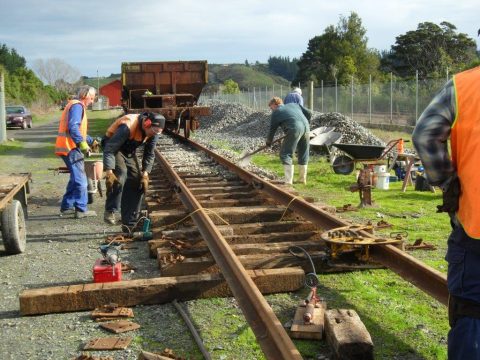
Work progressing on our mainline, up to and beyond the pedestrian crossing to the Tranz Metro station at Maymorn. Photos: Glenn Fitzgerald.
During the year we connected the double slip at Maymorn to our existing mainline track. 91LB rail for the first trackset was drifted down to the turnout structure, sleepers re-spaced and fastened down.
Six lengths of 50kg/m rail were swapped into the mainline, to keep a consistent rail weight, and to free up 91LB rail for other uses. The 91LB was needed to build another turnout and to complete the inspection pits inside the rail vehicle shed.

By 20 October 2012 we had just about completed the rail swap-out work, and have become well-practised at prepping rails for use.
The yard track includes a double-slip, two turnouts and an initial two tracks leading into the shed. Work has started on most of these items. Survey and design work has been completed to locate track centres and intersection points for the mainline, track structures and plain track.

Work continued this year on one of the key track structures for the Maymorn station yard — a 91Lb double slip. The major donor asset, a single-slip, was purchased from KiwiRail in 2009. In 2011-2012 much of the rail preparation had been completed, including rebuilding of the two inner slip frogs, closer and outer slip rails and outer frogs. During the 2012-2013 the structure was fastened down to sleepers, ballasted and tamped, connected to the existing mainline track and a newly built road-two turnout. Commissioning is planned for early in the 2013-2014 year. Motor points of M5-pattern have been placed near their final position. Once installed they are planned to eventually be operable from an adjacent control panel, and will also be suitable for manual operation.
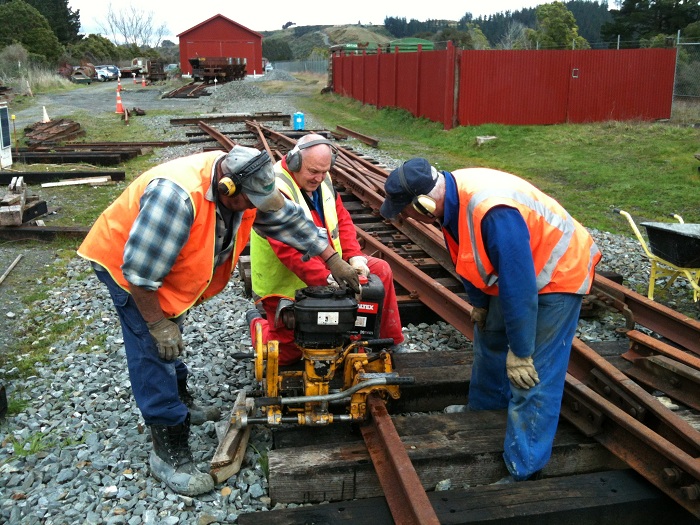
Colin, Peter and John drilling fishbolt holes in the doubleslip checkrail in August 2012.

On 29 December 2012 work to fasten down the double slip rails was well advanced, as was the construction of the road two turnout, in the foreground. Later that day the first rail vehicles passed over these structures through to the rail vehicle shed.
Work on the road two turnout was brought forward and completed this year, to connect the mainline and double slip to the shed yard. Careful measurement and survey work was done to locate the turnout, to ensure that the ladder road and the short curve between road 2 and road 1 turnouts were correctly aligned. Once survey work was completed the turnout components and lengths of rail were laid out, crowed to correct radius and cut to length. The turnout has a split lead, meaning that both legs have curvature, and both stock rails have a set applied ahead of the switches.
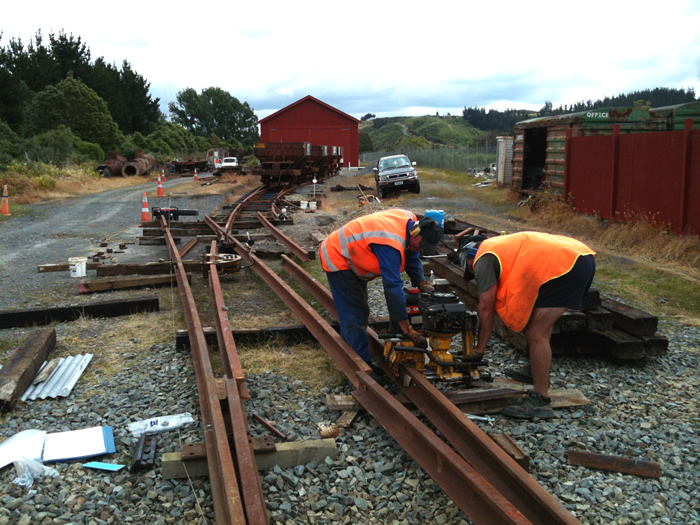
John and Colin drilling heel bolt holes in the right-hand stock rail, whilst the curved closer rail in the background was being crowed to the required radius. By the end of December 2012 the turnout was largely complete.
The turntable road was also brought forward and constructed in the 2012-2013 year, so that a temporary connection could be made with the Wairarapa Line, to receive in the 'Cyclops' English Electric multiple unit. The track was constructed to mainline standards, as it will eventually run down parallel with and past the rail vehicle shed and connect up to a turntable at the Upper Hutt end of the site. Six track sets were built during January — March 2013 ahead of the planned arrival of 'Cyclops' in Autumn.


On 10 March 2013 the turntable road was well advanced, with ballasting and tamping under way.
The Trust has brought together a collection of rail vehicles, many of which will in future take passengers on their journey over the Rimutaka Incline Railway. Other vehicles, such as the fleet of ballast wagons, will be used to build and maintain the railway line. Business needs, heritage value, authenticity and mechanical condition are some of the factors that have been considered when acquiring carriages, wagons, and latterly, locomotives.
The carriage fleet now totals seven, which when restored, will provide sufficient passenger accommodation for initial services. Carriage restoration work is pending completion of the rail vehicle shed and a thorough assessment of the fleet. A restoration plan will be developed, with priorities assigned based on carriage condition, anticipated traffic requirements and other factors. Restoration work will be hastened by facilities in our new workshop currently under construction. A key achievement for the year was the return to service of our shunting locomotive, Tr 189.
The Trusts safety case requires that vehicles operated by the Trust are inspected annually. This work has been progressing and the majority of our vehicles had an inspection during this period. With Tr189 now operational there is a greater need to inspect all our vehicles and implement a program to rectify safety related faults in a timely manner.
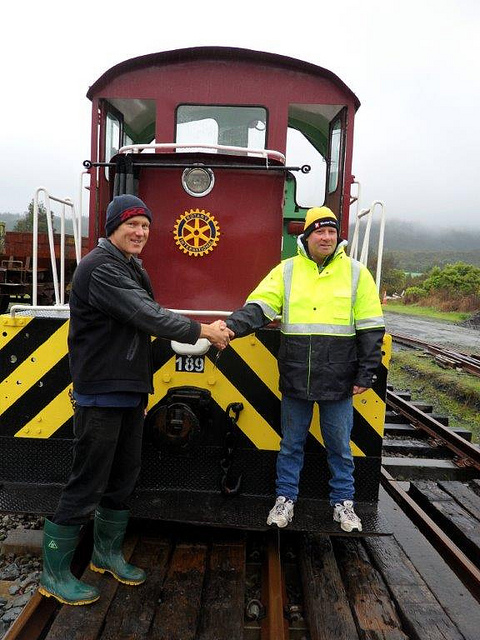
Kevin Joyce, right, and Hugh McCracken, left, celebrate unveiling of a Rotary International badge affixed to shunting locomotive Tr 189. A re-commissioning ceremony was held on 22 June 2013 with a Rotary roundel unveiled on the rear of Tr189 to recognise their assistance with the original purchase from KiwiRail. Photo: Glenn Fitzgerald.
Tr189 was one of nine 20-tonne shunting locomotives built to this design at the New Zealand Railways Hillside Workshops in Dunedin during the 1970s. Working in the Manawatu for much of its life, it had been stored out of service in Wellington for over a year before being purchased by the Trust. Its road number was changed from 189 to 937 in the late 1970s, part of a system-wide renumbering associated with the introduction of a computerised Traffic Monitoring System (TMS).
The Trust purchased shunting locomotive Tr189 from KiwiRail in July 2010. Thanks are due to members and Rotary Upper Hutt who made substantial donations towards the purchase and transport of the locomotive. The locomotive was transported to Maymorn on 30 July 2010, and has been stored in the shed since its arrival. Pending closing in of the rail vehicle shed, the locomotive was cleaned down, bodywork repaired and repainted into a scheme closely resembling the original livery it received at Hillside Workshops during its construction.
Some parts had been removed from the locomotive during its last years with KiwiRail to keep other class members running. We have managed to source the majority of the missing parts including a replacement starter motor and compressor. Thankfully the engine is a Gardner Marine engine and we have been able to source parts from www.gardner-enthusiast.com.
A mechanical assessment was done to determine the condition of the locomotive, including all systems and components, present and missing. A project plan was drawn up to return the locomotive to operational order, and to itemise funding to purchase a shortlist of missing components.
Interior and exterior painting work was completed during the year. The floor in the cab has been replaced and the electrical system has been overhauled, with missing components replaced. A few minor jobs were attended to on the electrical system and a set of replacement batteries were purchased. Components of the cooling system were overhauled, including the water pump. The air compressor was overhauled, replaced into the loco and the air system tested and passed. The oil cooling radiator was also been removed and repaired.
Whilst Tr189 is now operational and has been commissioned there are still a number of minor tasks to complete over the next year as funding and time permits.
The Trust is working on returning some of our Yc ballast wagons to service so that we use them to ballast the yard. Ron has done a magnificent job at painting the Yc817 in the correct livery and most of the lettering has been completed. We found that Yc 817 had a seized bearing on part of the door mechanism which required removal and repair. The work on the door mechanism and brake rigging has begun now that we could move the Yc over the pit.
Yc825: This is the second Yc that we have started work on and has also had a paint job by Ron. The control lever on the door mechanism has been found to have a bend in it that affects its operation. Once we can get a donor vehicle over the pit work on replacing the door control and overhauling the brake gear will begin.
Kp2118: Ron has been working on painting Kp2118 and carrying out a few of the required body repairs with the wagon beginning to look very smart. The handbrake on this wagon is seized and once the two Ycs are off the pits we will be starting repair work.

Ron painting Kp2118, Ben inspecting timber frame of A1896 in May 2013. Photo: Glenn Fitzgerald.
A1896: In order to have greater community involvement there is a requirement to have some operational carriages. In order to achieve the goal the Trust has begun preparing a conservation plan for this carriage and this is now at an advanced state. As part of this conservation plan Trust members removed a number of the body panels to inspect the condition of the body framing and have been documenting the surviving heritage features. The Trusts plan is to restore this car as close as possible to its original composite configuration and we are beginning to compile a list of the missing items that we will need to source to achieve this goal.
This carriage was one of three pressure ventilated composite 56 foot cars built at Otahuhu in 1941 for use on the Auckland – Opua expresses. The composite cars entered service in March 1941 with a composite car and a second class car detached at Otiria Junction for the service to Okaihau. A1896 is historically significant as while 56 foot Steel passenger cars became the mainstay of the NZR passenger fleet there were only 3 composite first/second cars were built.
Wb299 The underframe of this locomotive has been moved into the rail vehicle shed so that it is ready for members to begin work on. Work on returning this locomotive to service is planned to begin following the completion of the workshop shed.
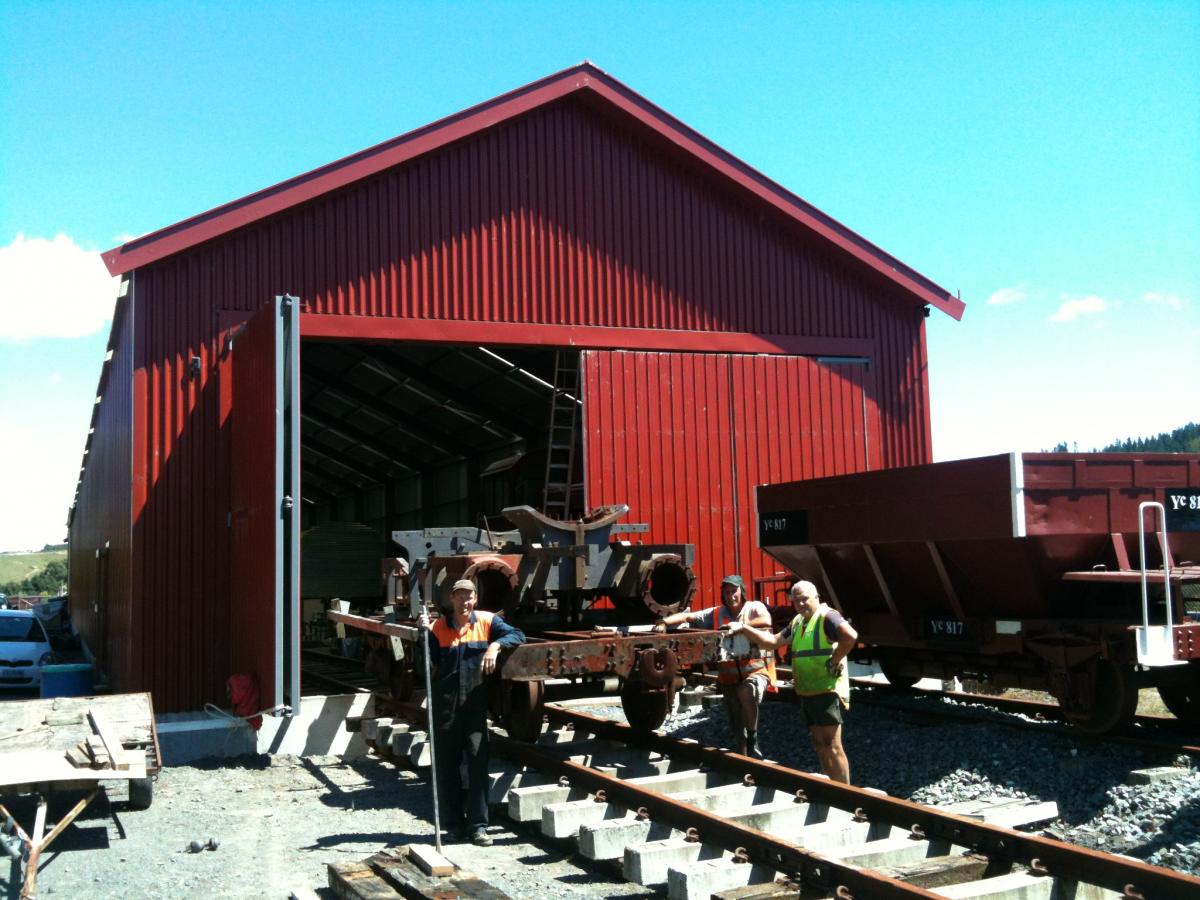
On Saturday 16 February 2013 the frames of steam locomotive Wb 299 were moved inside the rail vehicle shed at Maymorn. This was made possible by track work completed earlier in the day. Photo: Colin Craddock.
The Trust has assisted the Wellington Heritage Multiple Unit Preservation Trust by providing storage for these vehicles at our Maymorn site. These vehicles are currently covered under the Rimutaka Incline Rail Heritage Trusts Safety Case and all maintenance work will need to be done to the RIRHT codes. The WHMUPT plans to eventually gain their own Rail Operating Licence and when this happens there will be an access agreement for them to operate on the Trust's site.
One of the trailer cars could be suitable for giving members of the public a ride on the railway when towed behind Tr189. While not prototypical this will allow the Trust to provide members of the public with rides as an interim measure until one of the Trust's own carriages is returned to service.
WW7725 is an operational 4-man motor trolley owned by Steve Porter and has now been included in the Trust's Safety Case. This gives the Trust access to another operational vehicle that can be used to that can be used for inspections, maintenance work and safely carrying passengers on the railway.
WW7324 is an extended 2-man motor trolley owned by Ben Calcott and has now been included in the Trust's Safety Case. This motor trolley is currently stored off site and undergoing repairs to make it fully operational.
| Original No | TMS No | Year built | Where built | Arrival date at Maymorn | Notes |
|---|---|---|---|---|---|
| A189 | - | 1884 | NZR Workshops | 9 September 2009 | non-operational |
| A1896 | A56113 | 1941 | Otahuhu | 20 Dec 2005 | non-operational |
| A1914 | AL2044 | 1940 | Otahuhu | 21 Dec 2005 | non-operational |
| A1916 | A56247 | 1939 | Otahuhu | 7 Dec 2005 | non-operational |
| A1988 | A56750 | 1943 | Addington | 9 Dec 2005 | non-operational |
| A2000 | A56868 | 1940 | Addington | 8 Dec 2005 | non-operational |
| Aa1060 | - | 1909 | Petone | 4 May 2007 | non-operational |
| D113 | D2130 | 1954 | English Electric | 21 April 2013 | Operational |
| D138 | D2411 | 1954 | English Electric | 21 April 2013 | Operational |
| Dm48 | DM556 | 1954 | English Electric | 21 April 2013 | Operational |
| F605 | EA67715 | 1944 | Otahuhu | 23 Dec 2005 | non-operational |
| GM63 | ex-FM572 | 1977 | Mitsubishi, Japan | 3 April 2007 | non-operational |
| GM96 | ex-FM1070 | 1981 | Daewoo, Korea | 24 May 2006 | non-operational |
| GM97 | ex-FM1087 | 1981 | Daewoo, Korea | 20 May 2006 | non-operational |
| Kp1497 | KP6374 | 1961 | England | 27 July 2007 | operational |
| Kp2118 | KP12994 | 1965 | Mitsubishi, Japan | 9 August 2008 | operational |
| Kp2589 | KP17954 | 1966 | Mitsubishi, Japan | 8 August 2007 | non-operational |
| Kp3638 | ? | 1967 | Mitsubishi, Japan | 8 August 2007 | non-operational |
| Q1489 | Q8019 | 1953 | NZR | 23 July 2006 | operational |
| Q1534 | Q8407 | 1953 | NZR | 23 July 2006 | operational |
| Tr189 | TR937 | 1976 | Hillside | 30 July 2010 | non-operational |
| Wb292 | - | 1898 | Baldwin Locomotive Works #16172 | 9 August 2008 | non-operational |
| Wb299 | - | 1898 | Baldwin Locomotive Works #16175 | 9 August 2008 | non-operational |
| Wd356 | - | 1901 | Baldwin Locomotive Works #19260 | 23 July 2006 | non-operational |
| ww6921 | - | 1970s | East Town Workshops | 2012 | operational |
| ww6955 | - | 1970s | East Town Workshops | 2009 | operational |
| ww7730 | - | 1970s | East Town Workshops | 2009 | operational |
| Yc726 | YC308 | 1959 | NZR | 5 September 2007 | operational |
| Yc760 | YC654 | 1960 | NZR | 16 October 2007 | operational |
| Yc782 | YC1083 | 1959-1961 | NZR | 5 September 2007 | operational |
| Yc789 | YC1175 | 1959-1961 | NZR | 5 September 2007 | operational |
| Yc795 | YC1238 | 1959-1961 | NZR | 6 September 2007 | operational |
| Yc817 | YC1486 | 1959-1961 | NZR | 6 September 2007 | operational |
| Yc825 | YC1578 | 1959-1961 | NZR | 30 August 2007 | operational |
| Yc845 | YC1768 | 1961 | NZR | 30 August 2007 | operational |
| Yc877 | YC2139 | 1961 | NZR | 19 November 2007 | operational |
| Yc878 | YC2145 | 1961 | NZR | 28 September 2007 | operational |
| Yc891 | YC2289 | 1961 | NZR | 28 September 2007 | operational |
| Yc895 | YC2329 | 1961 | NZR | 31 October 2007 | operational |
| Yc896 | YC2335 | 1961 | NZR | 30 August 2007 | operational |
The 80-metre long, two-road rail vehicle shed is being constructed to securely store carriages, locomotives and other heritage rail vehicles, and to enable their restoration, maintenance and future operation. It will eventually be fitted out with inspection pits throughout much of its length and concrete floors. Construction of the 15x10-metre workshop is under way at the Upper Hutt end.
Construction work on the rail vehicle shed continued through the year. Wall cladding has been completed, the roof is "watertight" and the train doors have been installed. Road two of the inspection pits is able to be used, and the external shell is complete aside from gutters. As noted elsewhere, three carriages, wagons and our shunt locomotive are now housed in the shed. Volunteers have also benefitted from the shelter afforded by the shed and an increasing amount of rail vehicle maintenance work is being undertaken within.
The list of tasks remaining to be tackled to complete the shed are now significantly reduced. These include:
Work has continued on the 24-metre long inspection pit facility within the rail vehicle shed. A $11,000 grant towards this work received from Rimutaka Trust funded the concrete floors and long pit wall to the south end of the shed.
Trust members assembling formwork for walls in the inspection pit area of the rail vehicle shed.
During the year we completed the final length of road one inspection pit wall and most of the concrete floor slabs. Steel columns were fastened down onto studs set into the concrete foundations, and rails rolled and lifted into position. Effectively the high-level floor area is now linked with the rest of the shed, which is a considerable advance over the previous work-site conditions. The road two inspection pit area is already being used for maintenance and inspections of rail vehicles — the outcome desired for the facility.
Most floor slab reinforcing and a few additional supporting walls have formwork and reinforcing placed, pending building inspection and funding for final concrete pours.
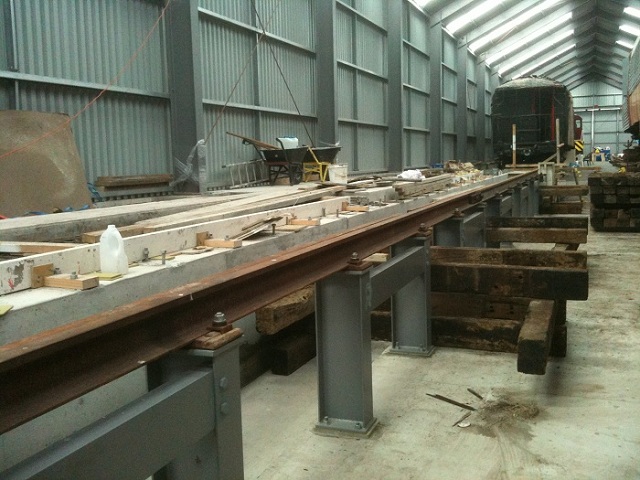
A length of rail placed on top of columns on 20 October 2013, the second pending completion of concrete floors.

Once completed the inspection pit facilities will be a tremendous asset for the Trust, enabling inspection, maintenance and repair activities to be carried out safely and efficiently. We are indebted to Rimutaka Charitable Trust, The Lottery Grants Board of New Zealand and Upper Hutt Cossie Club for supporting our work with these facilities.

On Sunday 14 April we connected the workshop portals to the existing rail vehicle shed with some fairly impressive stub beams. Photo: Glenn Fitzgerald.

Hammond Crane and Transport truck, lifting the second portal into position. A cherrypicker gave access to install DHS purlins to couple the two portals. All purlins and girts were fitted by the end of the day. Photo: Ben Calcott
Work has continued on the workshop extension to the rail vehicle shed. Four small portal pod extensions have been added to the existing shed foundations, and a new row poured to the south side of the shed. A lot of backfilling is required, but in the interim we plan to level out the foundation area with compacted fill. This will enable concrete trucks to access the wall sections and make the area safe for cherry-picker and other access equipment used for the main build.
Steel beams for the remaining two portal columns had been funded and purchased by the end of the year, with work well advanced towards a lift of the final portal frames in August 2013.

We are grateful for the continuing work of Bart Hogan and Graeme Bennett, who have looked after landscaping and replanting work at the Maymorn site. The front entrance to the site has been kept in a very presentable condition through the year, with lawns mowed and weeds kept under control. To the Kaitoke end of the site an area has been planted with native trees and shrubs. Once the plantings take hold the area will be relatively low-maintenance. It should provide a small habitat for native birds — and provide screening and privacy for neighbouring properties. We plan to carry out further planting at the site as earthworks are completed. Landscaping either side of the pedestrian crossing have also been planted with native shrubs, along with replanting and maintenance of screening plants adjacent to the rail vehicle shed.
The web site at www.rimutaka-incline-railway.org.nz is the Trust’s primary mechanism for the dissemination of information, and research outputs. This continues to be of benefit to both membership and the general public.
Search engine relevance (as returned by www.google.co.nz on 5 November 2013):
Photographs of physical progress with the Rimutaka Incline Railway have been published on Flickr: Rimutaka Incline Railway, a social media site enabling user-generated content, community and collaboration. A number of photo sets have been created, the principle ones being Head of steel covering track laying and Maymorn rail vehicle shed, which has had over 15,000 views by visitors to date.
A Flickr badge is embedded on the Trust’s web site, which has shown the three most recent photographs in the Maymorn rail vehicle shed set. Other options are possible and will be explored in the future.
The Trust has a Twitter profile: @rimutakaincline, with a history of more than 700 tweets, and more than 240 followers. In return, we follow and interact with close to a hundred other railways, locomotives, local businesses, local identities, politicians, railfans, Trust members and other people.

Photo: Hugh McCracken.
The Trust again had a display at the Railex Exhibition in October 2012, held at the Lower Hutt Horticultural Hall. A busy couple of days, with many people passing by our stand, and lots of conversations had with folk interested in our railway, and reminiscences of the old line over the Rimutaka's. Our display featured current progress being made with the rail vehicle shed and mainline track at Maymorn, along with plans for stage 1 to Kaitoke.
Membership numbers total fifty — a reasonable number considering the hard work involved in developing our Maymorn site. We plan to continue to grow our membership base in 2013-2014. Membership has been available since the Trust’s incorporation in 2003.
Two newsletters were published during the year:
Newsletter 31 - November 2012
Newsletter 32 - April 2013
The newsletters were sent electronically to members and stakeholders wherever possible, and put up on the Trust’s website a short time after publication.
Formal Trust meetings were held regularly through the year, with Special Trust meetings called from time to time to consider specific or pressing matters.
During the year a number of funding applications were made to: Cossie Club of Upper Hutt and Rimutaka Trust. Amounts granted are listed in the financial statements.
We are also grateful for on-going financial support gifted by the Rotary Club of Upper Hutt, funding a substantial portion of the purchase of shunting locomotive Tr189, water vats, carriages and materials for the workshop extension to the rail vehicle shed.
We are most grateful to Trust members and supporters who have generously donated funds and materials.
The work of the Rimutaka Incline Railway Heritage Trust would not be possible without the on-going support of local, regional and central organisations, and of course, the hard work of many volunteers. Support comes in many different forms, including donations and grants, both financial and in-kind, pro-bono technical and professional support and volunteer activity. We would like to thank the following organisations and people for their support:
The Trust gratefully acknowledges the support of Upper Hutt City Council.
The Trust would like to thank the following principal sponsors and partners for their support in this and previous years:
| NZ Lottery Grants Board | Protection of carriages and other rail vehicles through grant for rail vehicle shed |
|---|---|
| Rimutaka Charitable Trust | Continued support shown to the Trust, including significant funding towards the rail vehicle shed, carriage fleet and railway station design. |
| The Community Trust of Wellington | Protection of carriages and other rail vehicles through a grant for rail vehicle shed. |
| Hurlstone Earthmoving Limited | Excavation of railway formation at Maymorn station. |
| Rotary Club of Upper Hutt | Continued support shown to the Trust, including transport of sleeping carriage Aa1060 to site, purchase and transport of historic water vats and substantial contribution to purchase of shunting locomotive Tr189. |
| KiwiRail | Donation of track materials for mainline and loop, Maymorn. |
| Holcim NZ Ltd | Donation of ballast for mainline and loop, Maymorn. |
| Baldwin Steam Trust | Lease of Baldwin steam locomotives dating from 1898 and 1901. |
| Pelorus Trust | Cladding for rail vehicle shed, Transport of ballast wagons to Maymorn |
|---|---|
| The Lion Foundation | Protection of carriages and other rail vehicles through grants for rail vehicle shed. |
| Hutt Mana Charitable Trust | Protection of carriages and other rail vehicles through grants for rail vehicle shed. |
| New Zealand Community Trust | Sponsorship of ballast wagons |
| Rail Heritage Trust of New Zealand | Ballast for mainline, loop and station throat: Maymorn station |
| Upper Hutt Lions Club | Transport of carriage bogies from Huntly to Maymorn |
| Ron Greenwood Environmental Trust | Native tree establishment projects at Maymorn and Summit. |
| Upper Hutt City Council | Assistance with building consent and building inspection fees for rail vehicle shed |
|---|---|
| Paino and Robertson | Legal advice |
| Dunning Thornton Consultants | Discounted engineering work associated with rail vehicle shed and workshop |
| KiwiRail Network | Donation and discounted rates for surplus track, signalling and maintenance equipment |
| Forest and Bird, Upper Hutt branch | Native tree establishment plantings at Maymorn |
| Chris Northmore | Use of light truck and hiab |
| John de Graaff | Assistance with concrete floor finishing in the rail vehicle shed. |
| Trust members | We are indebted to Trust members for their significant contribution of voluntary work and donations. |
Financial statements for the 2012-2013 year are available from our website at www.rimutaka-incline-railway.org.nz/about-us.

Yc 817 and 825 over inspection pits in the rail vehicle shed on 4 May 2013. Both wagons had been repainted and were awaiting attention to brakes and ballast discharge door mechanisms. Photo: Hugh McCracken.